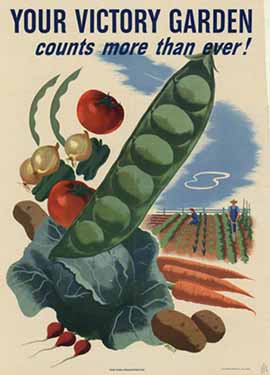

Victory gardens, also called war gardens or food gardens for defense, were vegetable, fruit and herb gardens planted at private residences in United States, United Kingdom, Canada and Germany during World War I and World War II to reduce the pressure on the public food supply brought on by the war effort. In addition to indirectly aiding the war effort these gardens were also considered a civil "morale booster" - in that gardeners could feel empowered by their contribution of labor and rewarded by the produce grown. Making victory gardens became a part of daily life on the home front.
Amid regular rationing of canned food in Britain, a poster campaign ("Plant more in '44!") encouraged the planting of Victory Gardens by nearly 20 million Americans. These gardens produced up to 40 percent of all the vegetable produce being consumed nationally.
It was emphasized to home front urbanites and suburbanites that the produce from their gardens would help to lower the price of vegetables needed by the US War Department to feed the troops, thus saving money that could be spent elsewhere on the military: "Our food is fighting," one poster read.
Although at first the Department of Agriculture objected to Eleanor Roosevelt's institution of a Victory Garden on the White House grounds, fearing that such a movement would hurt the food industry, basic information about gardening appeared in public services booklets distributed by the Department of Agriculture, as well as by agribusiness corporations such as International Harvester and Beech-Nut.
Victory gardens were planted in backyards and on apartment-building rooftops, with the occasional vacant lot "commandeered for the war effort!" and put to use as a cornfield or a squash patch. During World War II, sections of lawn were publicly plowed for plots in Hyde Park, London to publicize the movement. In New York City, the lawns around vacant "Riverside" were devoted to victory gardens, as were portions of San Francisco's Golden Gate Park.
In 1946, with the war over, many residents did not plant Victory Gardens in expectation of greater produce availability. However, shortages remained in the United Kingdom.
The Fenway Victory Gardens in the Back Bay Fens of Boston, Massachusetts and the Dowling Community Garden in Minneapolis, Minnesota, remain active as the last surviving public examples from World War II. Most plots in the Fenway Victory Gardens now feature flowers instead of vegetables while the Dowling Community Garden retains its focus on vegetables.
Since the turn of the century there has existed a growing interest in Victory Gardens. A grassroots campaign promoting such gardens has recently sprung up in the form of new Victory Gardens in public spaces, Victory Garden websites and blogs, as well as petitions to both renew a national campaign for the Victory Garden and to encourage the re-establishment of a Victory Garden on the White House lawn.
Victory garden Wikipedia